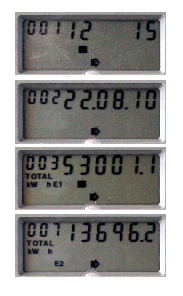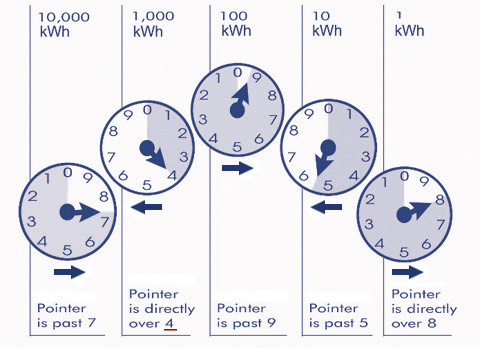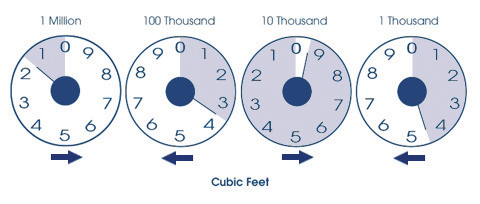On this page
Your energy meter - gas or electric - tracks the amount of energy you use and pay for at your property. Your retailer uses the meter to charge you the correct amount and your distributor can also use the information to plan and manage the need in your community.
Electricity smart meters
Smart meters are the new standard in electricity meters. They are digital and record your electricity use every 30 minutes. This means:
- you can see how much electricity you are using and when you are using it
- the quality of the power can be measured so the electricity distributor knows if there's an outage.
You will get a smart meter if:
- your existing meter is old or faulty and needs replacing
- there isn’t a meter at your property or it’s for a new connection - for example, if you are installing solar or building a new home.
You can say no to having smart meter installed. The retailer could also install one that can’t send data and a meter reader would visit your property to read it. But you might have to now pay for a manual reading.
Smart meters are required for rooftop solar PV systems.
Read a smart meter
The meter has a display screen which shows the collected information. Some also have a hot water boost button, and a service port.
Usage is displayed in kilowatt-hours (kWh) and can include energy:
- used in the home
- sent to the grid if you have solar
- used in the 30-minute block by off-peak or controlled load appliances. This only applies if you have:
- storage water heater of more than 125 litres
- underfloor heating
- a swimming pool or spa heater
- electric car charger
- battery storage.
There’s also a test pattern for the screen to show that all available characters are working.
Managing your use to save
You can see how much electricity you use at different times and compare it to the different rates. For example, you can track your use to:
- calculate how much your next bill might be
- limit use when the rate is higher
- shift your electricity use to cheaper, off-peak periods. For example, running the dishwasher overnight.
Energy retailers can also offer:
- flexible pricing deals
- more frequent bills, such as monthly instead of quarterly
- an energy use app, so you can see the reading on your phone.
Privacy
The data your smart meter collects is encrypted. It is sent to your retailer and distributor over secure networks. Your retailer uses the meter identification number - not your name and address - to match the data to your account details.
Smart meters can also be installed so they can’t send data and the retailer will visit your property to read the meter.
Other electricity meters
Accumulation meters record the amount of electricity that has passed through the meter since it was installed. Electricity is recorded in kilowatt-hours (kWh) and your bills are based on the differences between each time the meter is read.
Reading a digital accumulation meter
Scroll through the screens to get to the reading. Look for numbers starting with:
- 03 or 003 for the peak
- 07 or 007 for the off-peak.

Homes with solar panels will have an import/export meter. Look for numbers starting with 09 or 009 to see what has been exported to the grid.
Reading a clock face accumulation meter
- Read the dials from left to right, ignoring the one marked 1/10 as it's only used for testing.
- Each dial revolves in a different direction from the one next to it.
- If the pointer is directly over a number, underline that number.
- Write down the number the pointer has just passed.
- If any underlined numbers are followed by an 8 or 9, reduce it by one.

Calculate electricity costs
You can work out your electricity costs by:
- subtracting the previous meter reading from the current reading - this is your usage
- multiply that amount by the tariff on your bill to get an estimate of your costs.
Cost formula
You could also:
Off-peak power
Controlled or off-peak metering is only available on certain appliances. Power is supplied overnight, and the timing is worked out by SA Power Networks. Appliances that can be run on an off-peak tariff include:
- permanently installed storage water heaters with a capacity of 125L or more
- underfloor heating
- some swimming pool and spa heaters.
If you have a clock face meter you usually have two meters – peak and off-peak – and you will have:
- 2 meter numbers
- 2 readings on your bill.
Digital meters can record both peak and off-peak usage. There will be 2 charges on your bill - peak and off-peak - but only 1 meter number.
Gas meters
If you use gas in your home, you will have separate gas and electricity meters.
Read a metric or digital gas meter
Metric or digital gas meters record the amount of gas used in cubic metres (m3).
- Read the numbers from left to right.
- Only read the black and white numbers. Ignore red numbers, as these are used for testing.
Read a clock face gas meter
Clock face meters record the amount of gas used in cubic feet (ft3).
- Read the first four dials from left to right.
- Each dial revolves in a different direction from the one next to it.
- Write down the number the pointer has just passed - for example, if it is between 7 and 8, write down 7.
Calculate gas costs
Your bill shows gas use in megajoules (MJ). So, you'll need to convert your reading to MJ first, then you can work out the cost.
Convert to MJ by:
- subtracting the reading on the last bill from the current meter reading
- multiply that amount by the pressure factor and heating values found on a recent bill.
Can't find the pressure factor and heating values?
Convert to MJ formula
Cost formula
You could also:
Access to the meter
Your retailer should read your meter as often as needed to prepare your bill. But they are legally required to read it every 12 months. You must provide clear and safe access to your meter so they can.
Your retailer can estimate how much energy you consume, and they often do this if they can’t access your meter. Contact your retailer to agree on a convenient time to read the meter if it’s in a difficult location - for example, it’s indoors or behind a locked gate.
Estimated bills can lead to:
- high bills if your usage is over-estimated
- large catch-up bills if your usage is underestimated.
Smart meters don’t require a manual meter reading as usage data is sent digitally to your retailer.
Changing retailers
Your new retailer will take over the service but it's unlikely they will change the meter. You might need a new meter if the existing one can't support a service you've been offered. Retailers don't usually charge for new meters, but make sure you ask about changeover costs before you agree.
Smart meters are the standard for new meters. But you can say no to having one installed or the retailer could install one that can’t send data.
A smart meter will mean retailers can:
- remotely track your usage so manual readings aren't needed
- connect or disconnect supply when you move into a home, or switch retailers
- track and manage electricity generated from solar panels.
Comparing retailers and contracts, and choosing an energy deal
Related information
On this site
Energy bills, help and rebates
Other websites
- Understanding connectivity - Australian Government Department of Agriculture, Water and the Environment
- Energy and Water Ombudsman SA


